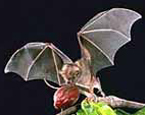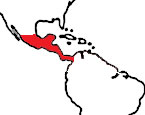|
Jamaican
Fruit-eating Bat
(Artibeus jamaicensis) |
||||
|
|
Physical
characteristics and distribution
|
|
A.
jamaicensis is one of the largest of the fourteen species
of Artibeus. The largest is A. lituratus with
a head and body length of 87-100mm, a forearm length of 64-76
mm, and weight of approximately 44-87 grams. The smallest is
A. phaeotis which has a head and body length of about
53 mm, a forearm length of 35-38 mm and weight of approximately
10 grams. The interfemoral membrane is narrow and lacks an external
tail. Coloration of the short, velvety fur ranges from dull
brown, gray or black with a silvery tinge. Underparts are usually
paler. There are four whitish facial stripes present, but no
light dorsal line. |
|
Description
of the brain
|
|
Animal
source and preparation
|
|
All
specimens collected followed the same preparation
and histological procedure.
|
Other Related Resources (websites and publications)
List of Specimens | Explore Collections | Brain Sections | Brain Evolution | Brain Development | Brain Circuitry | Brain Functions | Location and Use | Related Web Sites | Contact Us | Search MSU Database | Personnel | Home



